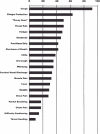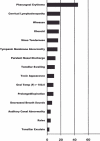Factors associated with antibiotic use for acute bronchitis
- PMID: 9734791
- PMCID: PMC1496997
- DOI: 10.1046/j.1525-1497.1998.00165.x
Factors associated with antibiotic use for acute bronchitis
Abstract
Objectives: To describe the clinical features of adults diagnosed with acute bronchitis, and to identify clinical variables associated with antibiotic treatment of acute bronchitis.
Design: Prospective, cohort study.
Setting: Primary care office practices at a group-model HMO in the Denver metropolitan area.
Patients/participants: Patients were adults seeking care for acute respiratory illnesses. Participating clinicians included internists, family medicine physicians, nurse practitioners, physician assistants, and registered nurses.
Measurements and main results: Clinicians voluntarily completed encounter forms for patients presenting with acute respiratory illnesses between February and May, 1996. Acute bronchitis was the primary diagnosis in 16% of acute respiratory illness visits (n = 1,525). The most frequent symptoms of acute bronchitis were cough (92%), phlegm production (63%), "runny nose" (50%), and throat pain (50%). The most frequent physical examination findings were pharyngeal erythema (45%), cervical lymphadenopathy (19%), wheezes (18%), and rhonchi (17%). Antibiotics were prescribed to 85% of patients diagnosed with acute bronchitis. Purulent nasal discharge by patient report, and sinus tenderness on physical examination were moderately associated with antibiotic treatment (p = .06 and .08, respectively). Antibiotic prescription rates did not vary by patient age or gender, duration of illness, days of work lost due to illness, or clinician type.
Conclusions: Acute bronchitis is frequently treated with antibiotics in ambulatory practice. The clinical factors we identified to be associated with antibiotic use for acute bronchitis appear to play a minor role in explaining the excessive use of antibiotics for this condition. These findings suggest that clinicians use the diagnosis of acute bronchitis as an indication for antibiotic treatment, despite clinical trials and expert recommendations to the contrary.
Figures



References
-
- Arnold KE, Leggiadro RJ, Breiman RF, et al. Risk factors for carriage of drug-resistant Streptococcus pneumoniae among children in Memphis, Tennessee. J Pediatr. 1996;128:757–64. - PubMed
-
- Hofmann J, Cetron MS, Farley MM, et al. The prevalence of drug-resistant Streptococcus pneumoniae in Atlanta. N Engl J Med. 1995;333:481–6. - PubMed
-
- Drug-resistant Streptococcus penumoniae—Kentucky and Tennessee, 1993. MMWR. 1994;43:23–6. - PubMed
-
- Cherian T, Steinhoff MC, Harrison LH, et al. A cluster of invasive pneumococcal disease in young children in child care. JAMA. 1994;271:695–7. - PubMed
-
- Reichler MR, Allphin AA, Breiman RF, et al. The spread of multiply resistant Streptococcus pneumoniae at a day care center in Ohio. J Infect Dis. 1992;166:1346–53. - PubMed
Publication types
MeSH terms
Substances
Grants and funding
LinkOut - more resources
Full Text Sources
Medical
